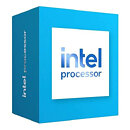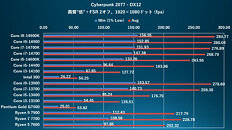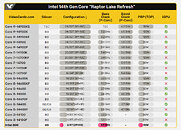T0@st
News Editor
- Joined
- Mar 7, 2023
- Messages
- 3,086 (3.90/day)
- Location
- South East, UK
| System Name | The TPU Typewriter |
|---|---|
| Processor | AMD Ryzen 5 5600 (non-X) |
| Motherboard | GIGABYTE B550M DS3H Micro ATX |
| Cooling | DeepCool AS500 |
| Memory | Kingston Fury Renegade RGB 32 GB (2 x 16 GB) DDR4-3600 CL16 |
| Video Card(s) | PowerColor Radeon RX 7800 XT 16 GB Hellhound OC |
| Storage | Samsung 980 Pro 1 TB M.2-2280 PCIe 4.0 X4 NVME SSD |
| Display(s) | Lenovo Legion Y27q-20 27" QHD IPS monitor |
| Case | GameMax Spark M-ATX (re-badged Jonsbo D30) |
| Audio Device(s) | FiiO K7 Desktop DAC/Amp + Philips Fidelio X3 headphones, or ARTTI T10 Planar IEMs |
| Power Supply | ADATA XPG CORE Reactor 650 W 80+ Gold ATX |
| Mouse | Roccat Kone Pro Air |
| Keyboard | Cooler Master MasterKeys Pro L |
| Software | Windows 10 64-bit Home Edition |
A conglomerate of Japanese hardware outlets has tested Intel's latest batch of Raptor Lake Refresh desktop processors—their findings arrived in the form of a YouTube video (viewable below). The lowly Intel 300 CPU was sampled as part of PAD's lab tests—this 14th generation model serves as a natural successor to Team Blue's Pentium Gold G7400 processor. Pentium and Celeron brands were retired in the "essential product space" in 2022, along with the introduction of a replacement: simple "Intel Processor" in a light blue color scheme.
Expectations are not set very high for a two-core, 4-thread CPU in modern times—some news outlets believe that this an Alder Lake part (AKA a frequency tweaked Pentium Gold G7400), despite being launched alongside many Raptor Lake Refresh parts. The Intel 300 sports two Raptor Cove P-cores with hyper-threading capabilities—base performance is set at 3.9 GHz, with no provisions for boosting above that figure. The rest of its basic specs consist of a 46 W TDP and 6 MB of L3 cache (3 MB on each core). Team Blue's Core i3-14100 quad core CPU sits just above the 300 in the latest batch of 14th Gen—naturally, the former pulls ahead of the latter in synthetic benchmarks. PC Watch and Co. tests present a maximum 55% multi-core performance gap between the two lower end options, although the single-threaded difference was measured 13% (in Cinebench).




An analysis of gaming benchmarks labeled the i3-14100 as a budget clear winner—Tom's Hardware summarized the brutal scenario: "not a surprising result considering it has twice the cores, twice the cache, and a frequency about 20% higher. Even for gamers only targeting 60 FPS, the 14100 provides an objectively better gaming experience as its 1% low framerate was always at least 60 FPS, which means the framerate virtually never dropped below 60 FPS. By contrast, the 300 had 1% low framerates significantly lower than 60 FPS in the two games."
PC Watch: "Many new models with improved cost performance have been added to Intel's latest CPU, Core processor (14th generation). We will evaluate these models, including the new entry model Intel 300 that replaces the Pentium/Celeron."
About "PAD" channel
This is a specialized channel for PC hardware and related information jointly brought to you by PC Watch, AKIBA PC Hotline!, and DOS/V POWER REPORT.
View at TechPowerUp Main Site | Source
Expectations are not set very high for a two-core, 4-thread CPU in modern times—some news outlets believe that this an Alder Lake part (AKA a frequency tweaked Pentium Gold G7400), despite being launched alongside many Raptor Lake Refresh parts. The Intel 300 sports two Raptor Cove P-cores with hyper-threading capabilities—base performance is set at 3.9 GHz, with no provisions for boosting above that figure. The rest of its basic specs consist of a 46 W TDP and 6 MB of L3 cache (3 MB on each core). Team Blue's Core i3-14100 quad core CPU sits just above the 300 in the latest batch of 14th Gen—naturally, the former pulls ahead of the latter in synthetic benchmarks. PC Watch and Co. tests present a maximum 55% multi-core performance gap between the two lower end options, although the single-threaded difference was measured 13% (in Cinebench).




An analysis of gaming benchmarks labeled the i3-14100 as a budget clear winner—Tom's Hardware summarized the brutal scenario: "not a surprising result considering it has twice the cores, twice the cache, and a frequency about 20% higher. Even for gamers only targeting 60 FPS, the 14100 provides an objectively better gaming experience as its 1% low framerate was always at least 60 FPS, which means the framerate virtually never dropped below 60 FPS. By contrast, the 300 had 1% low framerates significantly lower than 60 FPS in the two games."
PC Watch: "Many new models with improved cost performance have been added to Intel's latest CPU, Core processor (14th generation). We will evaluate these models, including the new entry model Intel 300 that replaces the Pentium/Celeron."
About "PAD" channel
This is a specialized channel for PC hardware and related information jointly brought to you by PC Watch, AKIBA PC Hotline!, and DOS/V POWER REPORT.
View at TechPowerUp Main Site | Source





